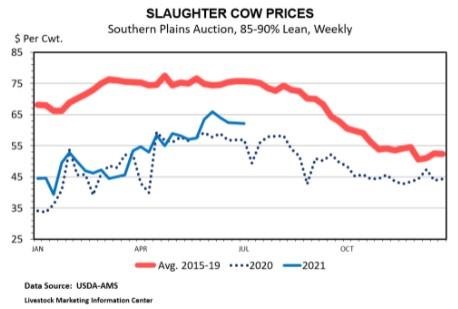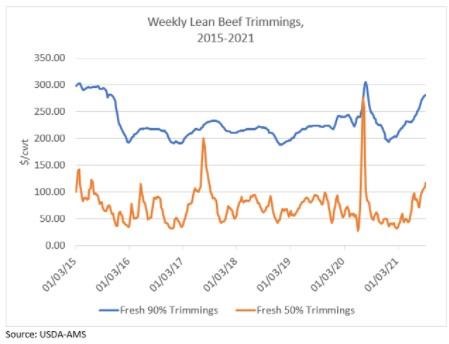By James Mitchell
Recently our colleague David Anderson at Texas A&M wrote an article that provided an update on cow slaughter and cull cow markets. You can read his article here. This week, I thought I would continue this discussion by examining one of the main drivers of cull cow markets, ground beef demand.

To review, cull beef cows contribute to ground beef production as a source of 90% lean trimmings, which are blended with 50% lean trimmings to make the majority of our ground beef and hamburger. The other two sources of lean trimmings are dairy cows and lean beef imports. Fed cattle trimmings are the main source of 50% lean trim.
Beef cow slaughter has been averaging 9.9 percent above 2020 slaughter and 12.4 percent higher than 2019 slaughter. This means a larger supply of lean trimmings from beef cull cows. All else equal, we would expect lower cull cow and lean trim prices due to larger supplies. However, this has not been the case this year.
Southern Plains slaughter cow prices have averaged 8.1 percent above 2020 and 14.7 percent above 2019 prices. Fresh 90% lean trimmings have averaged 4 percent below 2020 prices but 11 percent higher than 2019 prices. Lower dairy cow slaughter and beef imports (the other two sources of lean trim) have helped support cull cow and ground beef markets. Ground beef demand is the other factor driving cull cow values and lean trimmings prices.
Much like other meat prices, ground beef prices have averaged higher this year. Data through May 2021 from the Bureau of Labor Statistics shows that ground beef prices have averaged $4.04/lb or 0.5 percent higher than 2020. Lean ground beef prices have averaged 1.6 percent and 9.9 percent above 2020 and 2019 prices, respectively. The only way to have higher prices with larger supplies of cull cows and lean trimmings is with strong ground beef demand.

Source : osu.edu